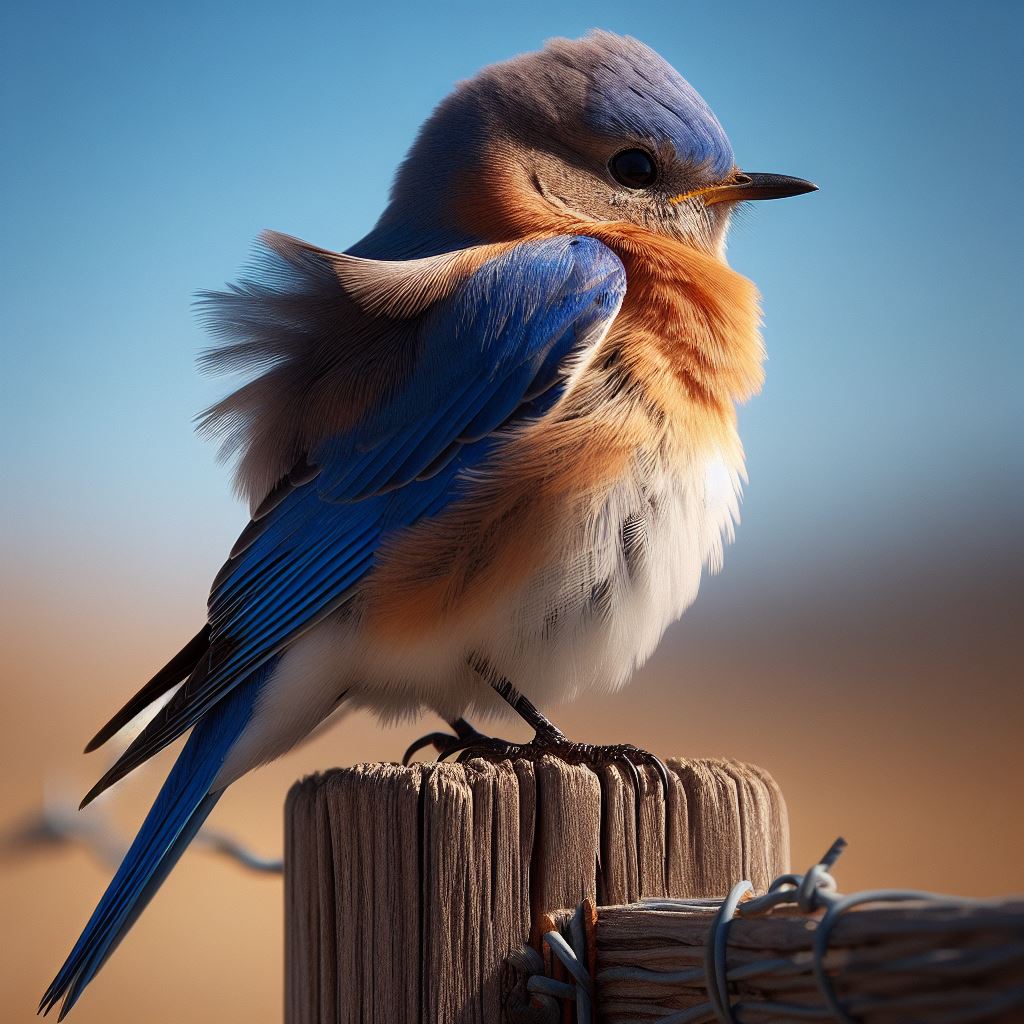Most beautiful small birds - Sykalo Eugen 2024
Eastern Bluebird (Sialia sialis)
Identification:
- Species name: Eastern Bluebird
- Scientific name: Sialia sialis
- Family: Turdidae (Thrushes)
- Order: Passeriformes (Songbirds)
- Subclass: Neornithes (Modern birds)
- Class: Aves (Birds)
Description:
- Size: Small, about 16-21 cm (6.3-8.3 in) long with a wingspan of 25-32 cm (9.8-12.6 in).
- Body shape: Plump and compact, with a large head, a short neck, and a straight, pointed beak.
- Plumage color:
Males (breeding season): Striking contrast of bright royal blue upperparts, a rusty orange throat and breast, and white underbelly.
Females and non-breeding males: Duller blue upperparts, paler orange breast, and more streaked underbelly.
Short, dark brown legs.
Black eyes.
Short, slightly forked tail.
- Beak: Short, straight, and pointed, dark grey in color, suitable for catching insects and berries.
Behavior:
- Method of feeding: Omnivorous, catching insects in flight, gleaning them from foliage, and eating fruits and berries.
- Reproduction: Builds cup-shaped nests in cavities in trees and nest boxes. Lays 3-5 pale blue eggs with speckled markings. Both parents care for the young.
- Movement: Migratory, breeding in eastern North America and wintering in the southern United States, Mexico, and Central America.
- Communication: Rich and varied song with melodic whistles, fluting calls, and mimicry of other birds. Males sing to defend territory and attract mates.
Ecology:
- Habitat: Open woodlands, farmlands, orchards, gardens, and parks with scattered trees and nest cavities.
- Diet: Insects, worms, snails, fruits, and berries.
- Hunting methods: Catches insects in mid-air, often hovering or perching in wait for prey. Also gleans insects from foliage and branches, and eats fruits and berries directly from bushes and trees.
Distribution: Found across eastern North America from Canada to the southeastern United States. Winters in the southern United States, Mexico, and Central America.
In a single sentence:

The Eastern Bluebird, a feathered jewel adorning North American backyards and open woodlands, might seem like a simple songbird at first glance. But beneath its vibrant blue plumage lies a treasure trove of fascinating facts and quirky adaptations that will leave you charmed by this avian ambassador of hope and happiness:
Melody Masters: The Eastern Bluebird's song isn't just a simple chirp; it's a joyous, flute-like melody that fills the air with optimism. They even incorporate mimicry, adding the calls of other birds to their repertoire, creating a vibrant avian orchestra. Imagine them as feathered troubadours with built-in musical libraries!
Insect Interceptors: Forget flytraps; Eastern Bluebirds are expert insectivores. Their sharp beaks and agile flight allow them to snatch buzzing prey mid-air with unmatched precision, keeping insect populations in check and adding a splash of blue to the air as they hunt. Think of them as feathered aerial acrobats with built-in flyswatters!
Unexpected Cavity Nesters: Eastern Bluebirds don't build elaborate nests in trees. They prefer the cozy havens offered by natural cavities or even nest boxes provided by humans. These adaptable feathered architects utilize whatever space is available, creating safe havens for their chicks.
Symbiotic Symphony: Bluebirds play a vital role in the ecosystem. By controlling insect populations, they help maintain the health of forests and meadows, contributing to a balanced natural symphony. These feathered pest controllers are gardeners of the sky, ensuring the flourishing of plants and other creatures.
Cultural Charmers: For centuries, the Eastern Bluebird has held a special place in North American cultures. It symbolizes happiness, hope, and new beginnings, often appearing in songs, poems, and even folk art. It's a testament to the enduring fascination we have with these feathered ambassadors of optimism.
Unexpected Family Helpers: Bluebird families aren't always limited to parents and chicks. Helpers, often older offspring or non-breeding individuals, sometimes assist the breeding pair in raising chicks, providing extra food and protection. It's a feathered commune with built-in childcare!
Hidden Vulnerability: Sadly, Eastern Bluebird populations faced decline in the past due to habitat loss and competition from other species. However, conservation efforts, including nest box programs, have helped their numbers rebound, offering a beacon of hope for the future of this cheerful songbird.
Unexpected Winter Warriors: While many songbirds migrate south for the winter, some Eastern Bluebirds choose to tough it out in colder climates. Their thick feathers and efficient metabolism allow them to survive in freezing temperatures, adding a splash of blue to the snowy landscapes. Talk about feathered Vikings with built-in winter jackets!